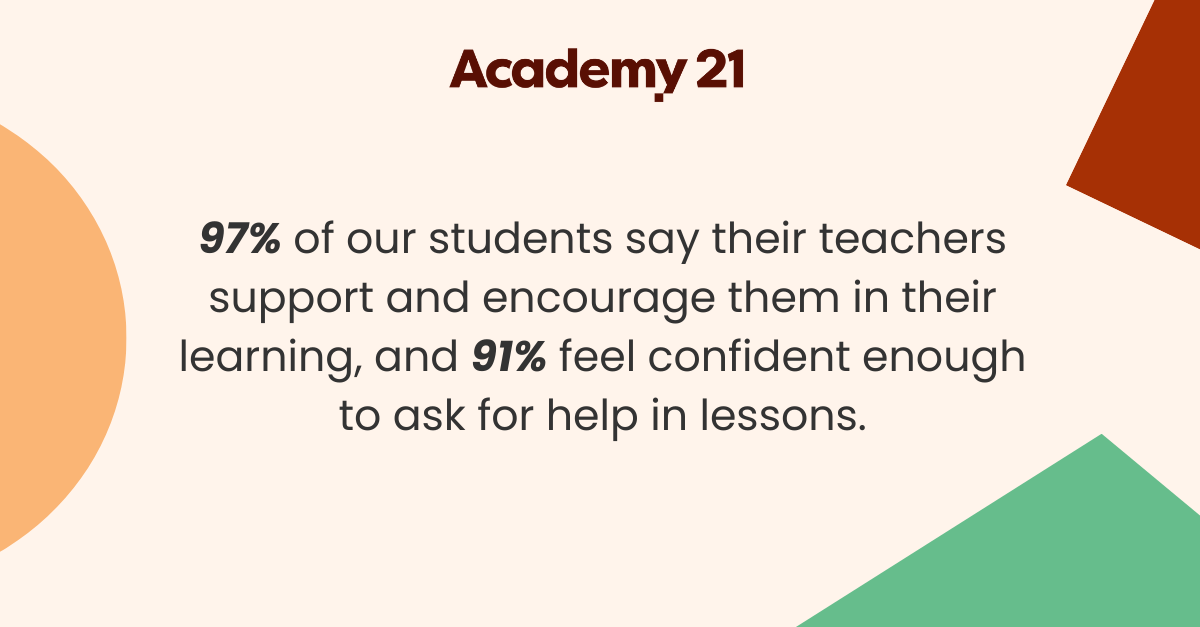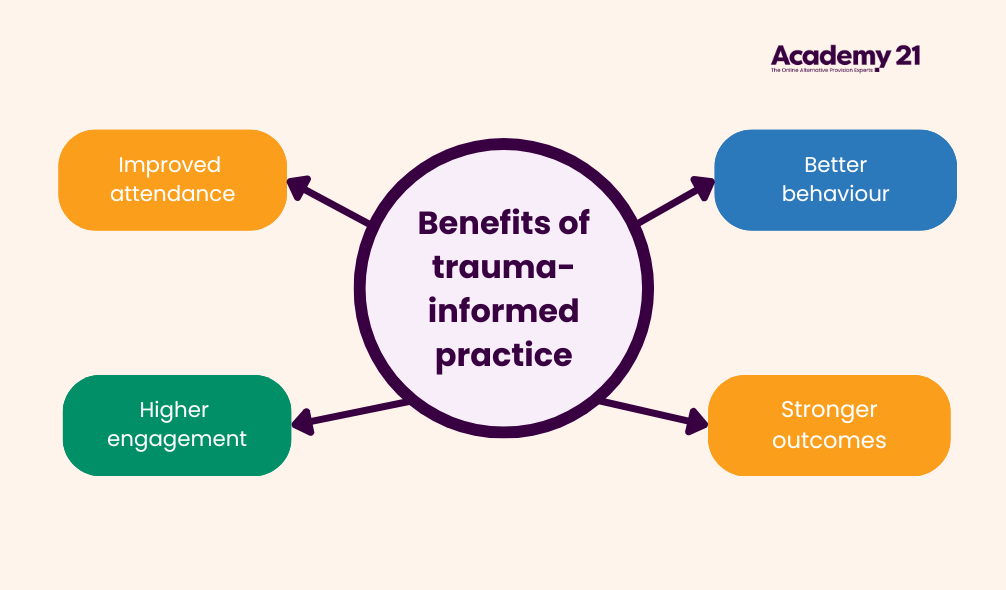What is trauma-informed practice, and how to implement it in your school

Across schools in the UK and beyond, teachers are seeing the same pattern: rising anxiety levels, inconsistent attendance, and pupils having difficulty engaging in learning. According to the NHS, 20.3% of children aged 8 to 16 are now likely to have a mental health challenge — a significant rise in recent years. Meanwhile, school leaders report an increase in emotionally based school avoidance and students finding it more challenging to cope with daily classroom life. In response, many schools are turning to trauma-informed practice to better support pupils’ emotional wellbeing and re-engage them in learning.
While not all behavioural or emotional challenges stem from trauma, many are linked to distressing life experiences that children and young people haven’t had the space, time, or support to process fully. These experiences might include:
- Bereavement
- Abuse
- Neglect
- Witnessing or experiencing violence
- Family separation or instability
- Chronic illness — either their own or a loved one’s
- Living in poverty or insecure housing
Such experiences can significantly impact a child’s ability to regulate emotions, trust adults, or feel safe in a learning environment. Trauma-informed practice recognises these effects and creates the conditions where healing, connection, and progress are possible.
What is trauma-informed practice?
Trauma-informed practices refer to ways of teaching, interacting, and organising learning environments that acknowledge the prevalence and impact of trauma on students. These practices promote psychological safety, positive relationships, and emotional regulation so pupils feel ready to learn.
The Department for Education defines trauma as experiences that lead to “lasting adverse effects, limiting the ability to function and achieve mental, physical, social, emotional or spiritual well-being.” Trauma-informed education works to mitigate these effects through intentional design of routines, systems, and relationships.
Rather than asking “What’s wrong with this student?” this approach encourages educators to consider “What might have happened to this student—and how can we help them feel safe enough to learn again?” It’s about creating consistency, reducing triggers, and responding with empathy and high expectations—not lowering the bar but changing how we help pupils reach it.
At Academy21, this approach is central to our online model. Many of our students arrive having experienced some form of trauma, and their ability to engage with school life has often been disrupted as a result. In this guide, we share what trauma-informed practice looks like in our setting — and how key principles can be applied in any school, physical or virtual.
Key principles of trauma-informed practice in schools
1. Safety and predictability
For students who have experienced trauma, unpredictability can be a significant trigger. Clear routines, consistent expectations, and emotionally safe environments can help re-establish a sense of control.
At Academy21, one way we embed predictability is through fixed timetables with the same teachers for each subject, at the same time each day. This familiarity builds a sense of trust and reduces the cognitive load for students who may already be overwhelmed. In physical schools, this could include:
- Visual timetables or lesson agendas
- Clearly communicated behavioural expectations
- Calm, structured transitions between activities
When routines are clear and consistent, students feel more in control of their environment. This helps reduce anxiety and supports emotional stability, enabling better focus and engagement.
2. Building trusting relationships
Relationships are at the heart of trauma-informed education. Pupils who have faced adversity often struggle to trust adults or feel a sense of belonging. Creating warm, respectful, and reliable interactions is vital.
Our teachers are trained to build supportive relationships with students, using consistent and validating interactions to foster trust and emotional safety. Simple practices like greeting students by name, following up after student absences, or checking in after difficult lessons go a long way in making pupils feel seen and valued.
97% of our students say their teachers support and encourage them in their learning, and 91% feel confident enough to ask for help in lessons, demonstrating how strong relationships translate into tangible benefits.

3. Emotional regulation
Trauma-informed classrooms don’t avoid challenge but equip students with tools to navigate it. This includes teaching emotional regulation skills, acknowledging stress responses, and offering meaningful opportunities for students to share their thoughts, queries, or concerns.
We use features like 1:1 chat pods, flexible breakout rooms, and access to designated staff for emotional check-ins. Students are also encouraged to share feedback regularly through surveys and a student council. Thanks to these initiatives, 94% of students say they enjoy their learning at Academy21, and 93% feel more confident in their learning since joining us.
Providing choices, where appropriate, also fosters a sense of autonomy. Whether it’s letting a student choose between writing or speaking, or allowing a short break, seemingly minor opportunities to make decisions about their own learning or classroom experience help restore a sense of agency and control, which trauma can often take away.
4. Staff training and reflective practice
Being trauma-informed is not an end state, but an ongoing process. That’s why whole-school training should be continuous and all-encompassing, focused on child development, the impact of adversity on the brain, and practical classroom strategies.
Academy21 invests in continuous professional development (CPD) to ensure staff have the understanding and the tools to support students affected by trauma. This includes peer-led discussions and professional development sessions around positive psychology and relational teaching. Staff are encouraged to reflect on their responses, examine potential triggers in lessons, and collaborate on solutions.
Importantly, we look at how trauma-informed principles translate to the online learning environment. We encourage teachers to tailor their lesson plans and approaches to each student’s needs to reduce anxiety and build confidence.
This includes guidance on relational teaching, restorative communication, and managing emotional responses — all key to building trust and resilience in students’ learning remotely.
95% of students say our technology helps them participate in lessons, highlighting how well-designed tools and trauma-informed pedagogy support active engagement.
The benefits of trauma-informed practice for learning and wellbeing
When trauma-informed practices are embedded effectively, the benefits can be wide-reaching, including:
-
Improved attendance: A trauma-informed environment prioritises emotional safety, helping students feel more secure and less anxious about entering the classroom. Over time, this sense of psychological safety can reduce school avoidance and encourage more consistent attendance.
-
Higher engagement: Trauma-informed classrooms foster stronger teacher-student relationships by emphasising empathy, predictability, and connection. This relational trust helps pupils feel understood and supported, making them more willing to participate and take academic risks.
-
Better behaviour with fewer punitive responses and more restorative ones. Instead of focusing on punishment, trauma-informed approaches seek to understand the reasons behind a student’s behaviour. This shift encourages restorative conversations and emotional regulation, reducing exclusions and promoting long-term behaviour change.
-
Stronger academic outcomes, particularly for previously disengaged learners. When students’ emotional needs are met, they can better access the curriculum and concentrate on learning. Trauma-informed strategies often re-engage learners who had previously struggled, helping them achieve academic success they might not have thought possible.

Bringing trauma-informed practice into any setting
While our work at Academy21 takes place online, the core principles of trauma-informed education are just as relevant in physical classrooms. Whether in mainstream schools, alternative provision, or specialist settings, educators can:
- Start with curiosity, not judgement
- Provide clarity and consistency in routines
- Focus on relationships as a foundation for learning
- Build in moments of choice and voice
- Make space for reflection and staff development
Embedding trauma-informed practice in every classroom
Trauma-informed practice is a mindset rooted in compassion, continuous learning, and the shared commitment to provide every child with the opportunity to thrive. At a time when student mental health is more vulnerable than ever, this approach is essential in every school setting.
Whether in person or online, schools that embrace trauma-informed principles can profoundly reshape the educational journey for their most vulnerable learners, helping them feel safe, supported, and ready to re-engage with learning.



